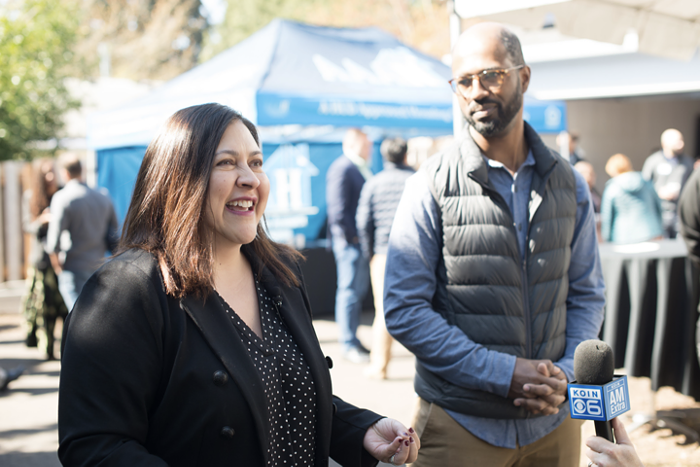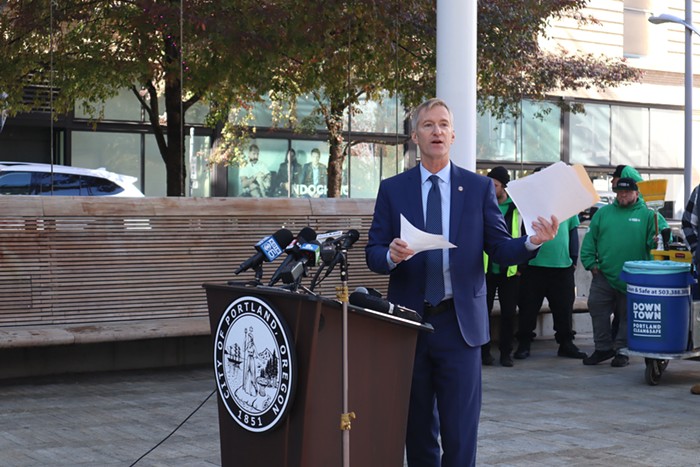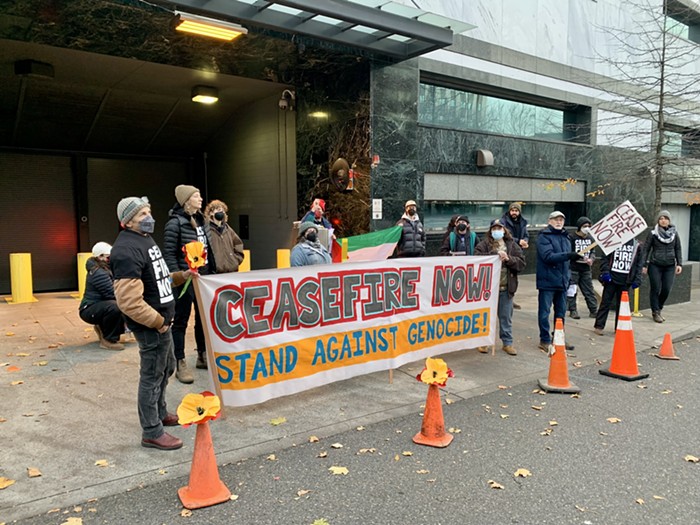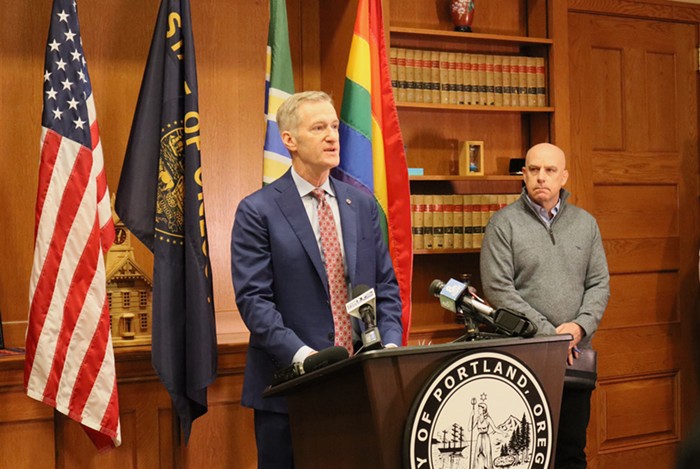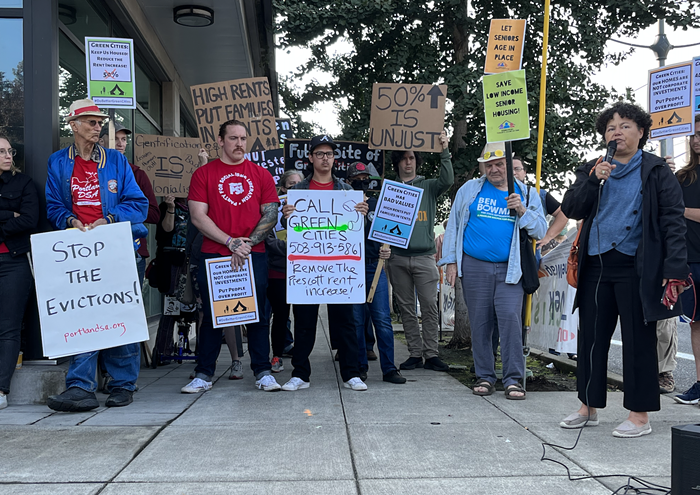
Eleven seconds.
That’s how much time workers at Troutdale’s Amazon Fulfillment Center have to pick up an item, scan it, and plop it into a designated cubby on one of the many towering yellow racks attached to Roomba-esque robots. If these employees, called “stowers,” can’t regularly hit this rate—around 3,000 items in a 10-hour shift—they’re fired.
“It’s an inhumane rate of production,” says Dan Maloney, who worked as a stower when he was first hired at the Troutdale warehouse. “And it’s incredibly harsh on the human body.”
Maloney, who asked the Mercury to protect his identity by using a pseudonym, began working at the facility in 2018. After four months of grabbing, scanning, and shelving items of all weights and sizes, Maloney’s left wrist and hand gave out. His doctor said he had a repetitive motion injury from holding a scanner and waving it over items at breakneck speed.
Maloney says that in his small group of other “veteran” workers who’ve been at the Troutdale facility for more than a year, all have sustained some type of injury from the job.
“Shoulder. Back. Neck. Arm,” he says, listing off his coworkers’ injuries. He’s seen dozens of employees be fired after an injury sustained at work slowed their production speed.
“Amazon doesn’t want any long-term workers,” he says. “They want you to work hard and fast and get rid of you when your body can’t take it anymore. That’s their business model.”
The injury rate of workers at Troutdale’s Amazon warehouse—called PDX9—is abnormally high, according to an investigation by Reveal, the multiplatform news organization from the nonprofit Center for Investigative Reporting. With the help of Amazon employees, Reveal was able to collect injury data from 23 of Amazon’s 110 fulfillment centers nationwide.
While Reveal’s journalists found that rate of workplace injuries at the Amazon warehouses they investigated is far above the industry standard, PDX9’s was easily the worst: According to Amazon’s records, 26 out of every 100 workers at PDX9 sustained an injury in 2018.
The Bureau of Labor Statistics, meanwhile, found that in 2018, the average injury rate for all “general warehousing and storage” facilities was 4 in every 100 workers.
Maloney says he wasn’t surprised to learn that PDX9 had the worst injury rate of any of the 23 Amazon warehouses in Reveal’s investigation.
“When you’re working against the standards of a robot, of course you’re going to push yourself too far,” Maloney says.
PDX9 is one of the growing number of Amazon warehouses in the US that relies on robots to improve efficiency. The robots, all carrying yellow racks, are programmed to zip across the 855,000 square foot warehouse to different work stations, cutting back on the time it would take for workers to track down merchandise on sedentary shelves.
It’s these robots that drew media attention to PDX9 when it opened in August 2018. At the time, Troutdale had recently awarded Amazon—which in 2018 was estimated to be worth $1 trillion—a five-year tax-break worth $9.6 million.
“This is a people-driven business,” PDX9 General Manager Mike Moore told KGW at the time, “and we complement that with the technology of robots.”

Some of the warehouse’s nearly 2,000 workers aren’t so sure their employer is “people-driven.” Before robots entered the picture, Amazon warehouse employees’ successes were measured against their most efficient coworkers. Now workers are expected to keep up with the production rate of robots. According to records acquired by Reveal, the US Amazon warehouses with the highest rates of injury are those with robots like PDX9.
Workers at PDX9 are directly overseen by computers that track their productivity rates and alert human managers when a worker is lagging. Maloney says that if a worker gets two “write-ups” from the computer in a single shift, that worker is fired. Warehouse employees also say they’re penalized for taking bathroom breaks, as any time away from their work station impacts their productivity rate.
Amazon spokesperson Shevaun Brown refuted those claims in an email to the Mercury.
"We have performance expectations for every Amazon associate and we measure actual performance against those expectations," Brown wrote. "Associate performance is measured and evaluated over a long period of time as we know that a variety of things could impact the ability to meet expectations in any given day or hour. We support people who are not performing to the levels expected with dedicated coaching to help them improve."
Brown said that Amazon does not monitor its employee's restroom breaks.
Like any US company, Amazon is required to report workplace injuries to the Occupational Safety and Health Administration (OSHA) if the injury requires time off for the worker, changes to the worker’s job, or medical treatment beyond first aid. The company must include a short description of the type of injury in that report.
PDX9’s log of reported injuries in 2018, obtained by Reveal, includes everything from “crushing/smashing industry, lower back” to “fracture, elbow” to “hernia, abdomen.” Out of the 184 injuries that were reported and recorded in 2018, 117 of them required the injured employee to take at least one day off work.
Maloney believes far more injuries went unreported, either because workers were afraid of losing their jobs for reporting an injury or because they quit after being injured.
“There’s no incentive to not get injured,” he says.
Brown said that PDX9's high injury rate is only proof of Amazon's meticulous record-keeping.
"While many companies under-record safety incidents in order to keep their rates low, Amazon does the opposite—we take an aggressive stance on recording injuries no matter how big or small, which results in elevated recordable rates and makes comparisons misleading," Brown said. "We err on the side of recording an injury versus not recording it, because continuous improvement is at the core of our culture—we want to keep getting better, and if you don’t have the data, improvement is difficult."
Also, failing to report a worker's injury to OSHA could stick Amazon with fines as high as $7,000.
In the past month, Maloney says he’s counted at least four ambulances arrive at PDX9 while he was working. PDX9 has an on-site health clinic, called AmCare, but the emergency medical technicians on staff only offer temporary relief with ice packs and Band-Aids.
While Maloney blames Amazon’s extreme productivity standards for most of the injures he’s witnessed at work, he also points to the company’s lack of worker training.
“I had a day of training when I was hired, and that just meant being shadowed by a manager on the floor. I was never given an employee handbook,” says Maloney. “The job standards change from manager to manager. There’s no consistency. It makes for an unsafe workplace.”
Amazon's Brown said that all new fulfillment center workers are given a manual and receiving training to "feel fully confident in their role."
But Maloney's experience sounds closer to reality to Carsen Harrison, a former employee at Portland’s Amazon Flex Warehouse—an Amazon shipping facility dubbed DPD1 and located on Northwest St. Helens. Harrison, who was hired to pull packaged boxes out of trucks and sort them by location, says she sat through two-hour PowerPoint training presentation before starting the rigorous job.
Like at PDX9, poor training paired with productivity requirements led to regular workplace injuries at DPD1.
“I remember lifting something up above my head onto a shelf and feeling my wrist pop,” says Harrison. “I had to wear a brace for a while. I didn’t report anything to management because there was this vibe of, ‘It’s a warehouse, you get hurt. Just deal with it.’”
Harrison did speak out after workers were routinely instructed to place rolling shelves in front of DPD1’s fire exits.
“I told management and, for a while, things changed,” she says. “But then managers just went back to telling people it was okay to block the exit. That they needed the space to be productive.”

While Harrison quit working at DPD1 in 2018—after seven months on the job—she still gets updates about working conditions from her old coworkers. One DPD1 worker recently told Harrison that the facility’s carbon monoxide alarm has gone off multiple times in recent months, but instead of evacuating the building, managers just open the facility’s bay doors and ask employees to continue working.
Since leaving Amazon, Harrison has joined a local group advocating for the rights of local Amazon employees. Called the Amazon Workers Solidarity Campaign (AWSC), the group holds off-site gatherings with Amazon workers to share concerns and brainstorm ways to improve working conditions.
Maloney, an active member of AWSC, says Amazon works hard to make sure its workers won’t unionize by pitting them against each other.
He points to a recent decision by PDX9’s management to give all night shift workers—himself included—a $2 an hour raise over the busy holiday months. The day shift workers, meanwhile, were given no bonus for the extra work.
After the announcement, Maloney says he noticed day shift employees making less of an effort to restock items and help prepare night workers for their shift.
“They want us to have conflict with each other,” says Maloney. “It keeps us from organizing against them.”
Since injuring his wrist, Maloney filed an injury complaint with OSHA. While the feds investigate his claim, Amazon has allowed him to take on a less-intensive job as a “packer”—someone who packages purchased items for shipping. The new position allows Maloney to use both hands, lessening the strain on his left wrist, and gives him 30 seconds to box up each item before sending it away on a conveyor belt. It makes his night shift, where he makes $17 an hour, slightly less painful.
“It’s better on my body,” Maloney says, “but I’m not healing.”
Maloney takes advantage of the brief moments before his shift to talk with coworkers about ways to advocate for their rights—from getting management to replace a broken, dangerous cart that workers load packages onto, to getting a full 30 minute break for lunch. (Currently, Maloney says, management includes the eight minutes it takes for workers to walk from the warehouse floor to the lunchroom and back in the time employees are allotted for lunch.) He’s convinced others to start attending AWSC meetings.
Maloney says his involvement with the AWSC has given him hope.
“Yes, there’s risk, every day, that I’ll be fired,” Maloney says. “But if there’s one thing that makes me want to go to work, it’s organizing. That’s why I still love this job.”
This story was completed with information from Reveal’s Reporting Networks: revealnews.org/network.



